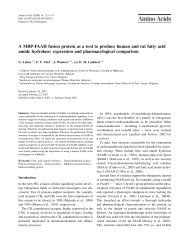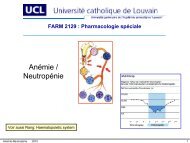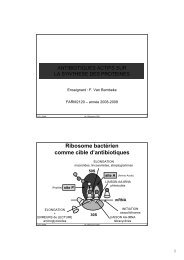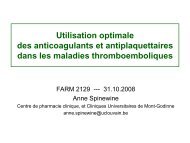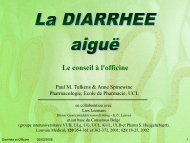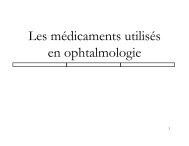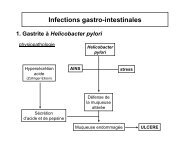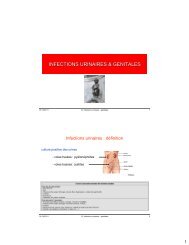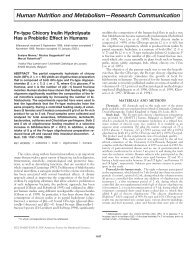Role of apoptosis for mouse liver growth regulation and tumor ...
Role of apoptosis for mouse liver growth regulation and tumor ...
Role of apoptosis for mouse liver growth regulation and tumor ...
You also want an ePaper? Increase the reach of your titles
YUMPU automatically turns print PDFs into web optimized ePapers that Google loves.
26 W. Bursch et al. / Toxicology Letters 149 (2004) 25–35<br />
1. Introduction<br />
Rodent species routinely used <strong>for</strong> life-time cancer<br />
studies on chemicals include <strong>mouse</strong> strains exhibiting<br />
a high (B6C3F1, C3H/He), but also a low (C57Bl/6J)<br />
susceptibility to spontaneous <strong>and</strong> chemically induced<br />
hepatocarcinogenesis (<strong>for</strong> review: Fausto, 1999, Gold<br />
et al., 2001). Elucidation the underlying causes is<br />
<strong>of</strong> great importance <strong>for</strong> risk assessment, but inspite<br />
<strong>of</strong> intense research ef<strong>for</strong>ts these still are a matter <strong>of</strong><br />
debate (Maronpot <strong>and</strong> Boorman, 1996; Alden, 2000;<br />
van Ravenzwaay <strong>and</strong> Tennekes, 2002). At the cellular<br />
level, cell replication <strong>and</strong> <strong>apoptosis</strong> are processes<br />
integrating all the genetic <strong>and</strong> molecular features <strong>of</strong><br />
the organism <strong>and</strong>, there<strong>for</strong>e may provide a clue to<br />
better underst<strong>and</strong> specificities in cancer susceptibility.<br />
Apoptosis constitutes an innate tissue defense against<br />
carcinogens by preventing survival <strong>of</strong> genetically<br />
damaged cells; the balance between cell proliferation<br />
<strong>and</strong> cell death determines the net <strong>growth</strong> <strong>of</strong> preneoplastic<br />
<strong>and</strong> <strong>tumor</strong> cell populations (Bursch et al., 1984;<br />
Schulte-Hermann et al., 1990; Grasl-Kraupp et al.,<br />
1997; Luebeck et al., 1995, 2000; Pitot et al., 2000;<br />
Lee, 2000). Consequently, block <strong>of</strong> <strong>apoptosis</strong> has been<br />
elucidated as prevailing mechanism <strong>of</strong> <strong>liver</strong> <strong>tumor</strong> promotion<br />
in many rodent studies, mostly using rat <strong>liver</strong><br />
models (Schulte-Hermann et al., 1990; Luebeck et al.,<br />
1995, 2000; Kolaja et al., 1996c; Schwarz et al., 2000;<br />
Pitot et al., 2000; O<strong>liver</strong> <strong>and</strong> Roberts, 2002; Tharappel<br />
et al., 2002). Relatively little is known about the role<br />
<strong>of</strong> <strong>apoptosis</strong> in determining cancer susceptibility in<br />
different <strong>mouse</strong> strains. Rather, based upon different<br />
experimental models somewhat conflicting data<br />
on <strong>apoptosis</strong> in <strong>mouse</strong> <strong>liver</strong> <strong>tumor</strong> promotion have<br />
been reported. For instance, <strong>growth</strong> <strong>of</strong> preneoplastic<br />
lesions, at least in early stages, has been attributed<br />
to predominantly depend on the proliferative activity<br />
while other studies described <strong>apoptosis</strong>-inhibition by<br />
<strong>tumor</strong> promoting agents (phenobarbital, peroxisome<br />
proliferators) as important determinant <strong>for</strong> <strong>tumor</strong> development<br />
in <strong>mouse</strong> <strong>liver</strong> (Pereira, 1993;Kolaja et al.,<br />
1996b,c; James et al., 1998; James <strong>and</strong> Roberts, 1996;<br />
Stevenson et al., 1999; S<strong>and</strong>ers <strong>and</strong> Thorgeirsson,<br />
2000; Goldsworthy <strong>and</strong> Fransson-Steen, 2002). There<strong>for</strong>e,<br />
we initiated a series <strong>of</strong> comparative short-term<br />
in vivo studies on <strong>liver</strong> <strong>growth</strong> (cell proliferation) <strong>and</strong><br />
involution (<strong>apoptosis</strong>) in C3H, C57Bl/6J <strong>and</strong> B6C3F1<br />
mice using the “classical” <strong>tumor</strong> promoter Phenobar-<br />
bital (PB) <strong>and</strong> the peroxisome proliferator nafenopin<br />
(NAF) as model compounds. The short-term experiments<br />
were complemented by a long-term carcinogenesis<br />
study with C3H/He, C57Bl/6J <strong>and</strong> B6C3F1 mice.<br />
Hepatocarcinogenesis was initiated by a single dose<br />
<strong>of</strong> N-nitrosodiethylamine (NDEA). Subsequently, we<br />
closely followed the <strong>growth</strong> <strong>of</strong> phenotypically distinct<br />
preneoplastic <strong>and</strong> neoplastic lesions as well as<br />
their DNA synthesis <strong>and</strong> apoptotic activitiy, without<br />
or with phenobarbital promotion. The experimental<br />
design was focussed to answer the question whether<br />
a high <strong>liver</strong> cancer susceptibility correlates with a<br />
failure <strong>of</strong> <strong>apoptosis</strong>. The present communication<br />
provides an excerpt <strong>of</strong> these studies to exemplarily<br />
highlight prominent species specificities <strong>of</strong> C3H/He<br />
<strong>and</strong> C57Bl/6J mice (parental strains <strong>of</strong> B6C3F1),<br />
C57Bl/6J both constituting the extremes in high <strong>and</strong><br />
low <strong>tumor</strong> susceptibility.<br />
2. Cell birth <strong>and</strong> cell death in normal <strong>mouse</strong> <strong>liver</strong><br />
(short-term studies)<br />
2.1. Liver <strong>growth</strong><br />
In male C57Bl/6J <strong>and</strong> C3H/He mice, PB treatment<br />
with doses <strong>of</strong> 500 ppm <strong>for</strong> 2 days followed by 750 ppm<br />
per day <strong>for</strong> 5 days via the diet caused an increase in<br />
<strong>liver</strong> weight by 40%–50% (Table 1). NAF treatment<br />
<strong>for</strong> 7 days, at the dose level chosen (500 ppm), caused<br />
a much more pronounced <strong>liver</strong> enlargement than PB<br />
in both strains <strong>of</strong> mice (85%–113% above controls,<br />
Table 1). Biochemical analysis revealed only a moderate<br />
increase in <strong>liver</strong> DNA (PB: about 8%–14%; NAF:<br />
8%–28%, Table 1). Thus, <strong>mouse</strong> <strong>liver</strong> enlargement in<br />
response to PB <strong>and</strong> NAF is largely due to hypertrophy,<br />
the extent <strong>of</strong> which -at least <strong>for</strong> PB-tended to be<br />
somewhat more pronounced in the highly susceptible<br />
C3H/He-mice (49% above control) as compared to<br />
C57Bl/6J mice (36% above control). In the <strong>liver</strong> <strong>of</strong><br />
PB-treated animals we also analysed the nuclear <strong>and</strong><br />
cellular ploidy pattern by histological-morphometrical<br />
means. As summarized in Table 2, 66%–75% <strong>of</strong> the<br />
hepatocytes contained two nuclei <strong>and</strong> binuclearity did<br />
not change significantly upon PB-treatment. As to<br />
nuclear <strong>and</strong> cellular ploidy, C57Bl/6J mice exhibited<br />
a slight but not significant shift in favor <strong>of</strong> 2 × 8n,<br />
1×16n <strong>and</strong> 2×16n hepatocytes, whereas in the <strong>liver</strong> <strong>of</strong>



